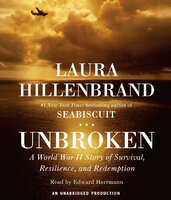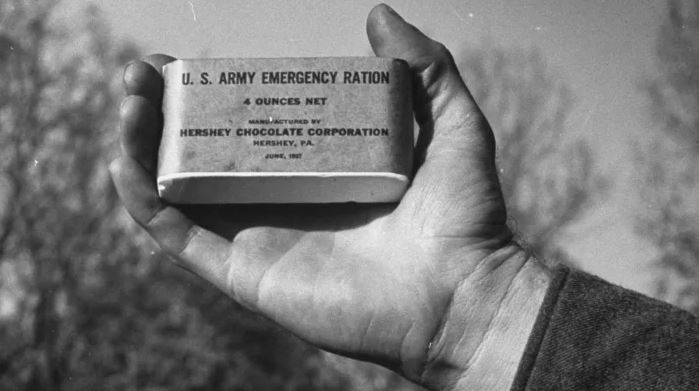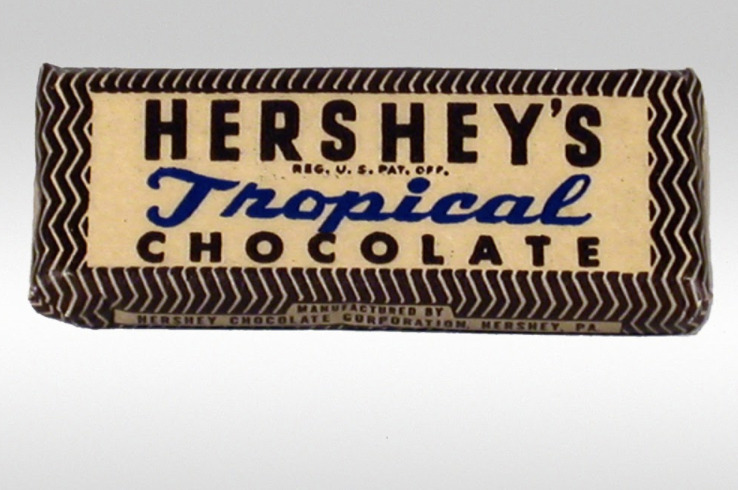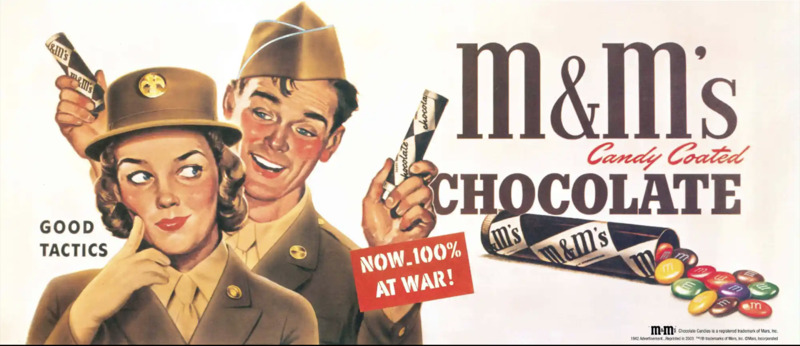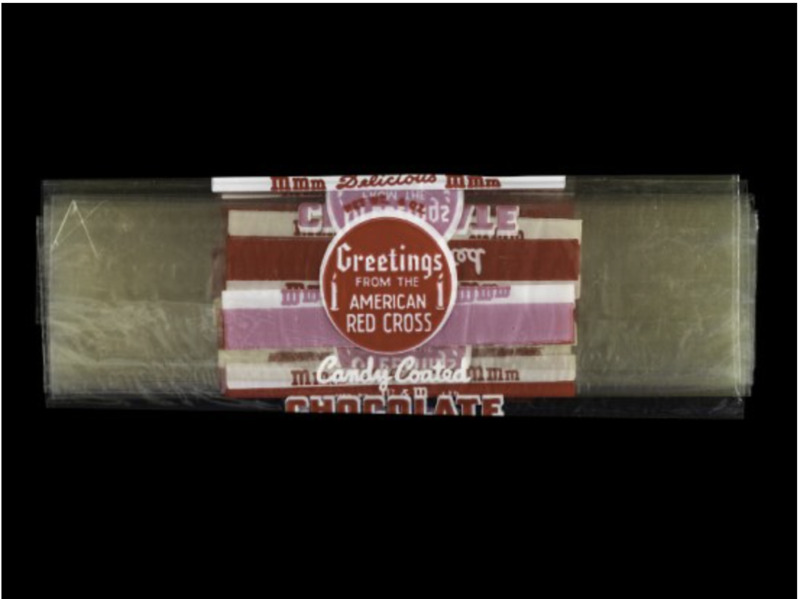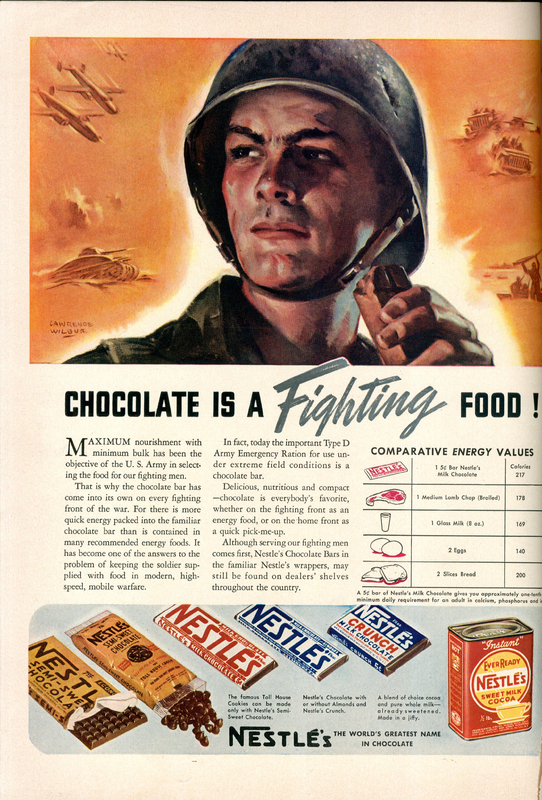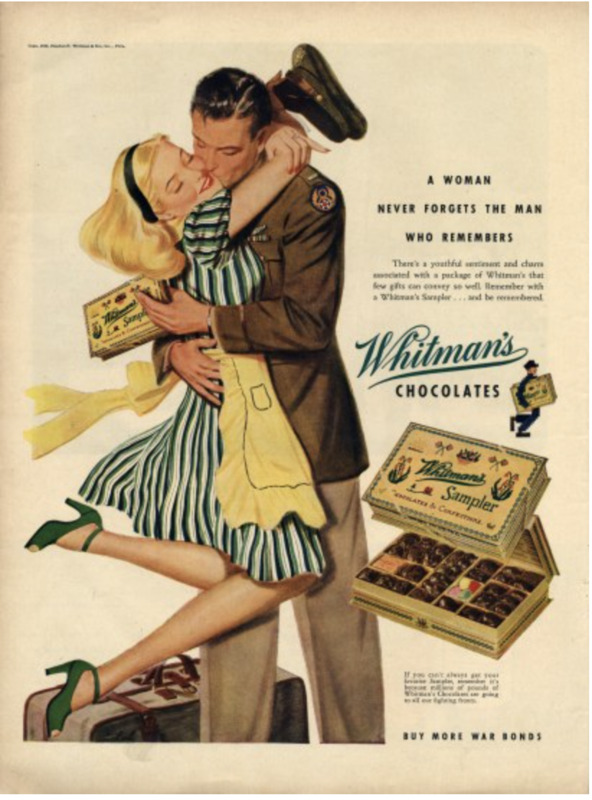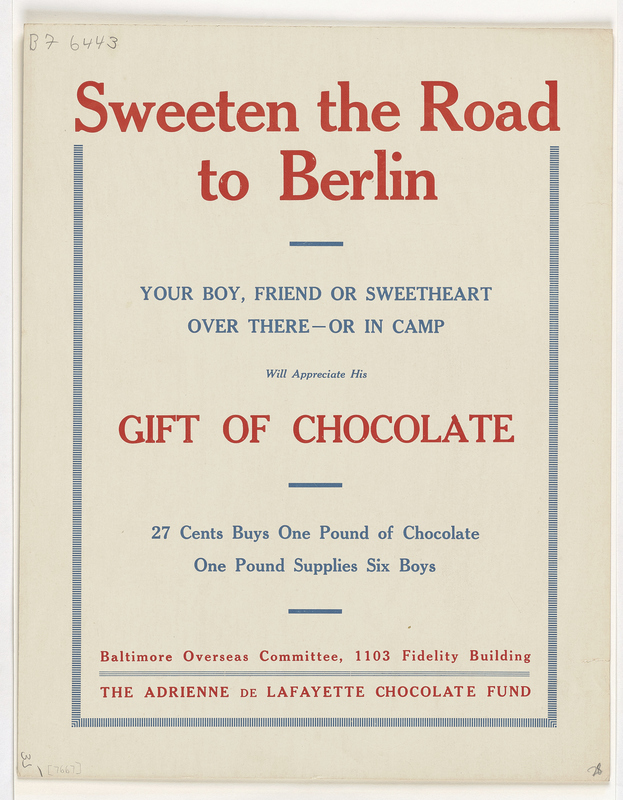World War II: "Chocolate "How to Save a Life"
While chocolate clearly played a role in every American military conflict from the Revolutionary War through World War I, chocolate was an even more important factor to America’s success in the Second World War. For example, Stephanie Butler, a noted food historian and author, highlights the importance of chocolate during World War II:
It’s one of the most celebrated feats of World War II: On June 6, 1944 more than 160,000 troops stormed the beaches of Normandy during the D-Day invasion. Less known is that an unlikely snack helped power the Allies before, during, and after the historic mission - Hershey’s chocolate bars. (1)
Despite initially sounding farfetched, chocolate literally saved American lives during World War II. More specifically, in the award winning book, Unbroken, Laura Hillenbrand describes the role that chocolate played in the survival of a group of American servicemen:
Pockets in the rafts contained some survival provisions. Whatever was in them was all that they’d have. Louie untied the pocket flaps and looked inside. He found several thick chocolate bars—probably the Hershey Company’s military-issue Ration D bars—divided into segments and packaged in wax-dipped containers to resist gas attack. Designed to be unpalatably bitter so soldiers would eat them only in dire circumstances, they were formulated to be highly caloric and melt-resistant. The package instructions said that each man was to be given two segments a day, one in the morning, one in the evening, to be held on the tongue and allowed to dissolve over thirty minutes. (2)
Unbroken was published in 2018 and the book tells the remarkable true story of Louis Zamperini, an Olympic runner, pilot, tortured POW, and American hero. During the Second World War, Zamperini’s plane was shot down over the Pacific Ocean and he survived by eating the D-Ration chocolate bars that were in his lifeboat.
As Louis Zamperini discovered, the Hershey’s Ration D bars were a critical source of sustenance for the American Armed Forces.(3) The Ration D bars were a blend of sugar, cocoa butter, skim milk powder, and oat flour. (4)
The accompanying image is a black and white photograph of a Ration D bar produced by Hershey. The photograph was taken in 1940 at Fort Myers. Subsequent to the production of the Ration D bar, Hershey introduced a new version, the Tropical Bar (seen below), which was designed not to melt when exposed to the high temperatures found in the military campaigns in the Pacific Theatre. (5) The Hershey Chocolate Corporation produced more than three billion bars to feed American troops during World War II. (6)
The Hershey Chocolate Corporation was not the only American chocolate manufacturer to support the war effort. In fact, Mars, Incorporated exclusively provided its newest product, M&M’s, to the United States Armed Forces during World War II. In addition to being lightweight and scrumptious, soldiers enjoyed that the candy “melted in their mouths not in their hands.” (7) In addition, as seen in the accompanying image, the M&M’s were distributed to the troops in lightweight tubes which made it easy to carry the candy. Mars did not provide M&M’s to consumers until 1947, two year after the end of World War II.
America’s other leading chocolate manufacturers, including Nestle and Whitman’s, also wanted to be associated with patriotism and the war effort during World War II. For example,
Lawrence Wilbur created the accompanying Nestle advertisement during the war. The Nestle advertisement obviously wants to associate its chocolate products with the American military. The advertisement describes chocolate as “fighting food” and the ad includes images of tanks, fighter planes, and a stoic soldier consuming a chocolate bar. The advertisement also connects its audience to the front lines by saying that chocolate is everyone’s favorite, whether it is eaten on the front lines as an energy food or on the homefront in order to receive a “quick pick me up.” (8) Furthermore, the accompanying image of a Whitman’s advertisement also attempts “to wrap its chocolates in the American flag” by including a picture of an American soldier as well as warning its audience that Whitman's products may be unavailable since millions of pounds of its chocolates were sent to American soldiers. (9) Finally, Whitman’s endeavors to further associate itself with the patriotic enthusiasm of the World War II era by including a line encouraging Americans to buy war bonds.
Lafayette College also participated in the connectivity between chocolate and the United States military during the Second World War. More specifically, the Adrienne Club, an association of women, comprised of the wives of students and faculty members at Lafayette, solicited donations to purchase chocolate for the American troops. The accompanying image asks potential donors, “To Sweeten the Road to Berlin.” The message is also patriotic because it predicts an American victory by having the American forces liberating the German capital of Berlin. (10)
An examination of the World War II era advertisements from Hershey’s, Mars, Nestle, and Whitman’s clearly embrace the “white-washed” image of traditional values. First, every person depicted in the ads is white despite the fact that approximately 1.2 million African American served in the armed forces during the Second World War.(11) In addition to African Americans, Asian Americans, Native Americans, and Latinos also served in the military. Notwithstanding, that fact, the chocolate manufacturers only included images of white soldiers. The chocolate advertisements were very consistent with the racist and sexist social hierarchy espoused by advertising companies, politicians, Hollywood, and most educational institutions at the time. Simply, white men, like the soldiers in the advertisements, fit the image of the American hero. Moreover, Whitman's advertisement utilizes the image of an American housewife dependent upon her husband’s return for her happiness. The blond woman is adorned with an apron; thereby, depicting her as a housewife. The advertisement again ignores the fact that women comprised thirty-seven percent of the American workforce in 1945. (12) The Lafayette College flier also represents the sexist realities of the era; women on campus were active in the Adrienne Club because Lafayette College did not admit women until 1969.
1. Butler, Stephanie. “How Hershey's Chocolate Helped Power Allied Troops during WWII.” History.com. A&E Television Networks, June 6, 2014. https://www.history.com/news/hersheys-chocolate-allied-d-day-rations-wwii.
2. Hillenbrand, Laura. Unbroken: A World War II Story of Survival, Resilience, and Redemption. New York, NY: Ballantine Books, 2018, 84.
3. Butler, Stephanie. “How Hershey's Chocolate Helped Power Allied Troops during WWII.” History.com. A&E Television Networks, June 6, 2014. https://www.history.com/news/hersheys-chocolate-allied-d-day-rations-wwii.
4. Butler, Stephanie. “How Hershey's Chocolate Helped Power Allied Troops during WWII.” History.com. A&E Television Networks, June 6, 2014. https://www.history.com/news/hersheys-chocolate-allied-d-day-rations-wwii.
5. Butler, Stephanie. “How Hershey's Chocolate Helped Power Allied Troops during WWII.” History.com. A&E Television Networks, June 6, 2014. https://www.history.com/news/hersheys-chocolate-allied-d-day-rations-wwii.
6. Butler, Stephanie. “How Hershey's Chocolate Helped Power Allied Troops during WWII.” History.com. A&E Television Networks, June 6, 2014. https://www.history.com/news/hersheys-chocolate-allied-d-day-rations-wwii.
7. Archives Foundation. History of Chocolate and the Military, 2020. https://www.youtube.com/watch?v=JNOEP2LLENA.
8. Wilbur, Lawrence. “Nestlé's Advertisement; ‘Chocolate Is a Fighting Food.’” Omeka RSS, 2019. https://archives.library.wcsu.edu/omeka/items/show/4576.
9. Sean Jacobson, October 24. “‘Chocolate Is a Fighting Food!" – Chocolate Bars in the Second World War.” National Museum of American History, March 11, 2020. https://americanhistory.si.edu/blog/chocolate-bars-second-world-war.
10. The Adrienne Club Lafayette College. “Princeton University Poster Collection: Contents.” SOVA. Accessed October 27, 2021. https://sova.si.edu/details/NMAH.AC.0433#ref8672.
11. Clark, A. (2020, August 5). Black Americans who served in WWII faced segregation abroad and at home. History.com. Retrieved December 6, 2021, from http://history.com/news/black-soldiers-world-war-ii-discrimination.
12. History.com Editors. (2010, March 5). American women in World War II. History.com. Retrieved December 6, 2021, from https://www.history.com/topics/world-war-ii/american-women-in-world-war-ii-1.

